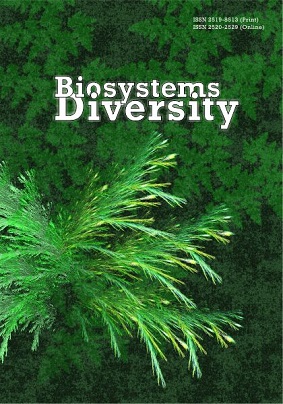Ecological and physiological peculiarities of bryophytes on a post-technogenic salinized territory
Ecological and physiological peculiarities of bryophytes on a post-technogenic salinized territory
Author(s): O.V. Lobachevska, N.Y. Kyyak, I.V. RabykSubject(s): Energy and Environmental Studies, Physical Geopgraphy, Human Ecology, Environmental interactions
Published by: Дніпропетровський національний університет імені Олеся Гончара
Keywords: salt stress; tailings storage; moss reproduction; carbohydrates; cation exchange capacity; plant ecomorphogenesis;
Summary/Abstract: Taxonomic, biomorphological and ecological structures of bryophytes, their reproductive strategy and the main mechanisms of tolerance in the conditions of salinization were investigated. Bryophytes are the pioneers that have colonized the territory of a tailing storage that holds liquid waste from potassium-magnesium concentrate production of the Mining and Chemical Enterprise "Polymineral". Due to excess salts, the soil solution in the shore area of the tailing pond acquires high osmotic pressure. Three experimental plots which differed significantly in the level of the substrate salinity were laid at the distance of 3, 6 and 9 m from the reservoir for experimental studies. Water extracts of the substrates from the test sites showed the highest concentrations for sulfates – 10.4–64.6 mg Eq/100 g of soil and chlorides – 7.6–43.3 mg Eq/100 g of soil. It was established that the investigated areas of the tailing storage territory differed in the biochemical activity of the substrate, which was evaluated by its redox potential. On the areas of the uncovered substrate it was the lowest – 230 mV, which indicates anaerobiosis in conditions of very high salinization and moisture. Higher ROP values were determined at the sites of bryophyte cover distribution – 295–330 mV. The aim of the study was to determine the features of taxonomic, biomorphological and ecological structures of bryophytes, their reproductive strategy and to establish the main mechanisms of adaptation to the conditions of salinization on the tailing storage territory. 24 species and 3 varieties of bryophytes, belonging to 12 families and 16 genera were found on the shore of the tailing storage pond. The results of biomorphological and ecological analysis of bryophytes indicate the uneven conditions of the habitats and their considerable ecological plasticity. Among the bryophytes, mesophytes, xeromesophytes and meso-eutrophs, eutrophs with a life-form of low dense and loose turf dominated. In salinization conditions, dioicous acrocarpous mosses prevailed, the fertile turf of which, depending on the influence of abiotic factors, differed significantly in the number of sexual shoots, their ratio and productivity. Bulbils were found only on the tips of Bryum argenteum shoots. Along with Salicornia europaea L., a euhalophyte, the leading role in the initial stage of overgrowth of the tailing storage area most often belonged to Didymodon rigidulus, Bryum argenteum, Funaria hygrometrica and Barbula unguiculata. The process of formation of bryophyte cover occurred along a gradient of decrease in salt concentration at the experimental sites. Adaptation of bryophytes to substrate salinity is due to a change in metabolic processes, which is manifested in an increase of the total content of carbohydrates and an increase of the cation exchange capacity of moss cell walls, which is the primary barrier that reduces the toxic effect of ions under salt stress.
Journal: Biosystems Diversity
- Issue Year: 27/2019
- Issue No: 4
- Page Range: 342-348
- Page Count: 7
- Language: English

